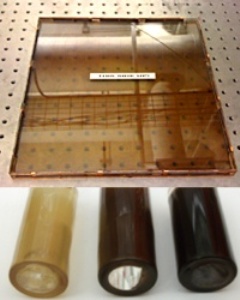Researchers belonging to the University of California, Merced, have achieved a critical breakthrough in the process of harvesting solar energy. They have modified the design of luminescent solar concentrators so as to increase their efficiency in directing sunlight to solar cells.
 UC Merced researchers discovered that hollow cylindrical luminescent solar concentrators are more efficient than traditional flat panel concentrators. Photo: UC Merced University Communications
UC Merced researchers discovered that hollow cylindrical luminescent solar concentrators are more efficient than traditional flat panel concentrators. Photo: UC Merced University Communications
Sayantani Ghosh, Professor of physics at UC Merced, led the project. Ajay Gopinathan, a physics professor, Richard Inman and Georgiy Shcherbatyuk, graduate students and Dmitri Medvedko, an undergraduate student formed the research team.
Conventional luminescent solar concentrators have a flat design. The research team modified the shape of the concentrators into cylinders, which led to a significant improvement in efficiency.
Luminescent concentrators absorb a considerable amount of light that they produce, which should have been transported to solar cells. This negative quality has prevented the commercial viability of the concentrators.
The research team found that when compared to solid cylinder or flat solar concentrators, the hollow cylindrical concentrators demonstrated more sunlight absorbing capacity and less self-absorption.
Luminescent solar concentrators employ down-converting. While they absorb solar radiation emitted over a wide range of colors they re-emit the radiation in a narrower range, typically in a single color, such as red. The concentrator has embedded quantum dots that perform the color conversion. This light is then transported for generating photocurrent to the solar cells. These solar cells can function even on cloudy days, hence the need of tracking mechanisms to direct them to face the sun is eliminated.
The hollow cylindrical luminescent solar concentrators do not cost more than conventional luminescent solar concentrators, as they utilize the same amount of quantum dots. They also hold the potential for integration onto windows, walls and other vertical surfaces.
Further research will endeavor to develop a large array of these solar concentrators and also monitor the panel’s efficiency.
The study was published in Optics Express, titled, "Cylindrical luminescent solar concentrators with near-infrared quantum dots."